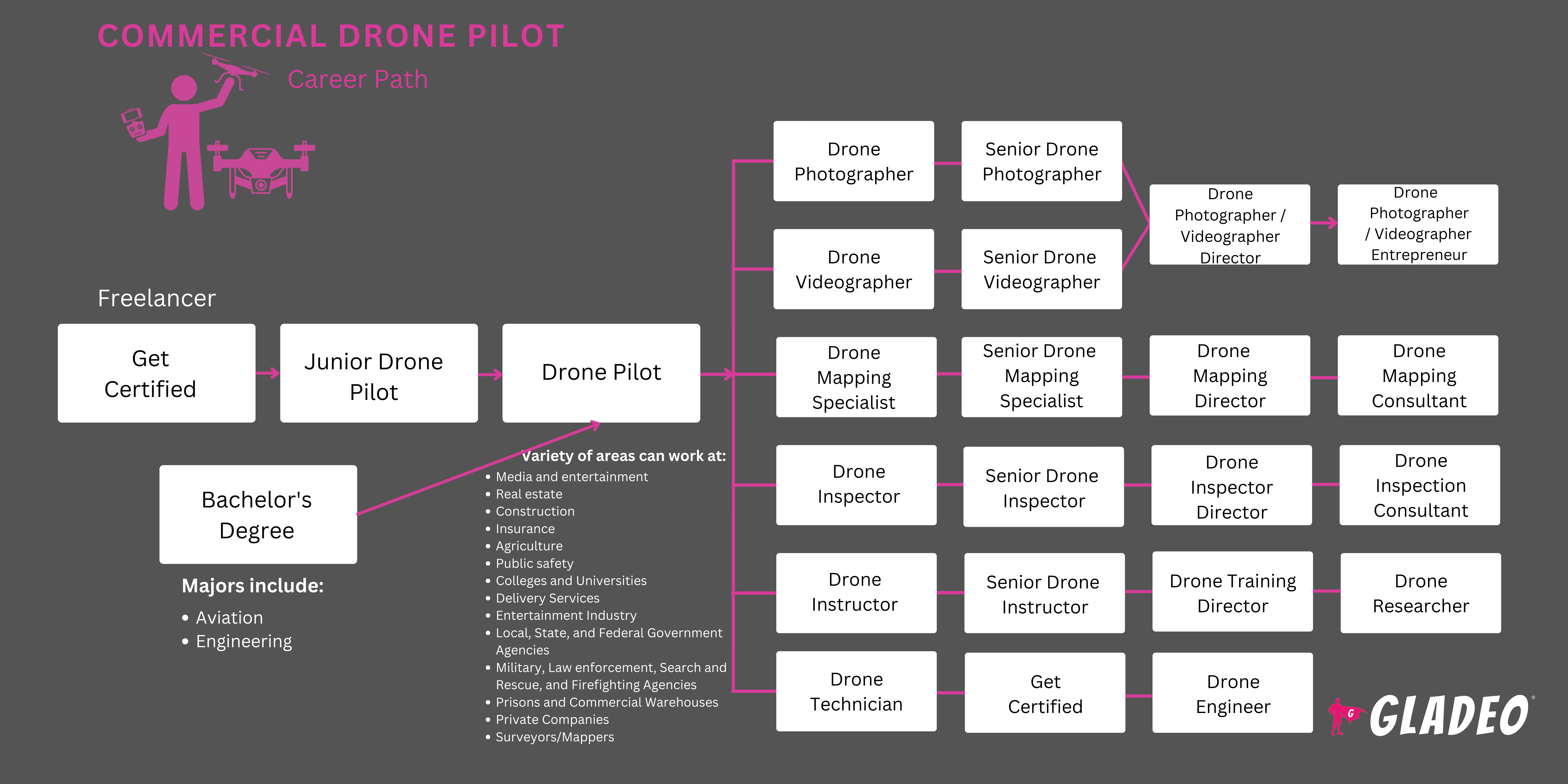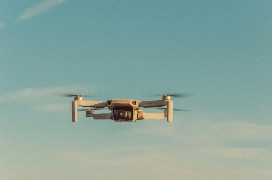Spotlights
Aerial Drone Operator, UAV Pilot (Unmanned Aerial Vehicle Pilot), Drone Flight Specialist, Drone Videographer, Drone Photographer, Remote Pilot in Command, Drone Operator, Aerial Cinematographer, Aerial Surveyor, Drone Technician
Incredibly, the concept of unmanned aerial vehicles has been around since at least 1849, with the first pilotless aircraft used in World War I. Today, remote-controlled drones are everywhere, used for everything from hobbies to surveillance, search and rescue, firefighting, land surveys, and more. Drones come in all shapes and sizes, ranging from the ones you can hold with two fingers (like the Black Hornet Nano) to fighter jet-sized models (like the 80’ Ravn X, believed to be the largest ever made).
Larger drones require trained Commercial Drone Pilots to operate them remotely. Drones are used in dozens, if not hundreds, of industries—but the pilot’s job is relatively the same no matter what purpose is being served. They must comply with FAA guidelines, maintain and operate the UAV safely, navigate around obstacles, and protect people and property from accidental collisions. It can be a fun career, but just like any pilot job, it comes with plenty of responsibility and liability.
- Getting paid to fly drones—which many people do as a hobby!
- Providing a valuable service to clients in a wide range of industries
- In some cases, helping to save lives, wildlife, property, or money
Lịch làm việc
- Commercial Drone Pilots may work full- or part-time jobs, depending on their position. There is obviously a lot of work outdoors, standing for long periods while staying focused on precision piloting a UAV (and operating attached equipment such as cameras). Frequent travel is often required within the local vicinity.
Nhiệm vụ tiêu biểu
Commercial drones are used for countless operations. But while the purposes may vary, the typical duties of the pilot are relatively the same for most positions.
- Meet with clients to discuss objectives, capabilities, and potential problems or risks
- Review the desired coverage area
- Determine the perimeter within which the drone will be in the remote control range
- Transport UAVs to launch destination(s)
- Manage all ground and flight operations
- Plot or help to plot flight planes
- Conduct pre- and post-flight checks
- Review weather forecasts for different altitudes
- Fly drones via remote-controllers
- Monitor in-flight operations and constantly assess potential problems such as low battery charges, being out of range, high winds, or dust
- Read, understand, and comply with Federal Aviation Administration regulations (including updates)
- Collaborate closely with clients and team members to ensure objectives are met
- Take aerial photos or videos for real estate, construction, entertainment, or advertising purposes
- Conduct surveys to gather information for maps
- Fly drones into potentially hazardous areas to aid with inspections and risk analysis (for example, to help law enforcement or firefighters)
- Operate thermal imaging cameras or monitoring equipment
- Upload and download data captured by drones
- Utilize AI-enhanced software for added functionality such as image recognition and obstacle avoidance
Trách nhiệm bổ sung
- Perform routine maintenance, repairs, or upgrades—or report the need for these actions to applicable technicians
- Demonstrate drone capabilities to clients, stakeholders, investors, or the general public
- Offer consultations or training to military drone operators
- Be very familiar with drone operator manuals, parts, and onboard/cloud software
- Update software manually, as needed
- Train and mentor other pilots
Kỹ năng mềm
- Ability to bend, squat, pull, and reach
- Ability to lift ~30-50 lbs or more
- Ability to tolerate exposure to outdoor conditions
- Ability to walk and stand for long periods
- Chú ý đến chi tiết
- Định hướng mục tiêu
- Sáng kiến
- Kỹ năng lãnh đạo
- Tinh ý
- Tổ chức
- Kiên nhẫn
- Giải quyết vấn đề
- Đánh giá rủi ro
- Tập trung vào an toàn
- Kỹ năng giao tiếp mạnh mẽ
- Làm việc theo nhóm
- Quản lý thời gian
- Độ sắc nét của thị giác
Kỹ năng kỹ thuật
- Remote Pilot Certificate from the FAA (also known as a “Part 107 license”)
- Bằng lái xe
- Familiarity with onboard and cloud service drone software, as well as hardware and data upload/transfer functions
- Familiarity with weather conditions and their impact on drone flight
- General knowledge of basic arithmetic, geometry, physics, computer science, and electrical components
- Knowledge of aviation safety and FAA regulations
- Agricultural agencies
- Các trường cao đẳng và đại học
- Các công ty xây dựng
- Delivery services
- Entertainment industry
- Các cơ quan chính phủ địa phương, tiểu bang và liên bang
- Military, law enforcement, search and rescue, and firefighting agencies
- Prisons and commercial warehouses
- Công ty tư nhân
- Cơ quan bất động sản
- Surveyors/mappers
On the surface, the job of a Commercial Drone Pilot might seem fun and easy. However, operating a high-tech drone requires a lot of focus and precision, sometimes under stressful conditions.
Like pilots who sit in a cockpit, Drone Pilots are flying equipment in the air, often over buildings and people. They must be extremely cautious to ensure their UAV is fit to fly, has enough charge to stay in the air for the specified period of time, and doesn’t fly beyond the range where it can be remotely controlled. Many drones are easily capable of flying past the pilot's visual line of sight, which greatly increases the risk of hitting something—or someone! Pilots who operate in such conditions require a waiver from the FAA.
UAV technology is advancing every year, with drones getting both bigger and smaller to perform a broader range of functions. While military applications have driven much of the research and development behind these advances, commercial applications have also expanded.
Drones are now being put to use to map out physical objects from all angles so that the captured data can be used to make “digital twins”—small but highly-detailed replicas on an object that can be used to aid in construction projects.
Another hot trend is “Drones-as-a-Service,” where customers share a problem and get a custom-scaled drone solution presented to knock it out in no time. Speaking of solutions, one of the biggest drawbacks of drones is the need for human operators. While this may not be great news for Commercial Drone Pilots, artificial intelligence is creeping in to help make drones more autonomous.
Commercial Drone Pilots often start as hobbyists before getting into the field as a profession. Some may have been aviation enthusiasts in general who grew up interested in piloting either aircraft or UAVs. Drone Pilots are both independent and team players who can work with others to achieve goals and overcome obstacles. They might have enjoyed group activities in school while being just as content working or playing on their own. They typically enjoy thinking with hardware and software and appreciate being outdoors where they can watch their drones soar through the skies!
- Commercial Drone Pilots don’t necessarily need a college degree, though many do get a bachelor’s in aviation or engineering
- Having real-world experience in aviation and drone piloting is crucial and is often gained from hobby flying or drone training programs
- Private companies like Dronitek offer drone pilot training that covers topics such as:
- Manual and autonomous flight-missions
- Data processing apps
- Use of cameras and sensors for inspections, mapping, modeling, first responders, search and rescue missions, etc.
- To work as a Commercial Drone Pilot, applicants need a Remote Pilot Certificate from the FAA (i.e., a “Part 107 license”)
- Criteria to get a Remote Pilot Certificate vary depending on if the applicant is a “first-time pilot” or has a Part 61 Certificate (a pilot's license for manned aircraft)
- First-time pilots must be at least 16 years old, must know English, be physically and mentally fit to fly a drone, and be able to pass an aeronautical knowledge exam (the Unmanned Aircraft General – Small)
- The Unmanned Aircraft General – Small test covers topics such as:
▸ Airspace classification
▸ Aviation weather
▸ Effects of drugs and alcohol
▸ Emergency procedures
▸ Loading and performance
▸ Night operations
▸ Preflight inspection procedures
▸ Radio communications
▸ Unmanned aircraft system (UAS) regulations
- As part of the fitness check, applicants will undergo a background check by the Transportation Security Administration (TSA). This is a standard check to ensure pilot applicants don’t have any serious criminal offenses related to aviation or that might otherwise indicate unsuitability
- Part 61 Certificate holders need a current cert and flight review
- Note, the Remote Pilot Certificate must be renewed every two years
- After certifications, drones must be registered (or re-registered if shifting from recreational to commercial use)
- Commercial Drone Pilots often opt to complete specialized operations training to boost their employability and income potential! Special cert options include:
- Aerial mapping and 3D modeling
- Industrial inspection
- Thermal imaging
- While Commercial Drone Pilots don’t need a college degree, many do enroll in drone pilot training to boost their knowledge and skills.
- This training can also help students prepare for the rigorous FAA Remote Pilot Certificate aeronautical knowledge exam (the Unmanned Aircraft General – Small).
- Several companies offer UAV pilot training courses. Cost and accessibility are factors to consider, but also look at how much practical hands-on experience the course offers. Getting plenty of flight time practice is crucial!
- Get started flying drones as a hobby to see if you have an aptitude and affinity for it
- Go to spots where you can be around other, more advanced drone pilots to observe their actions and potentially learn from them
- Join local UAV clubs to make friends, learn new things, and stay motivated
- Work with a mentor to “buddy box” drone controllers. This will allow you to practice your flight skills while having an experienced flier ready to take control of the drone, if needed
- Watch YouTube channels like UAV Coach to get some free training lessons and discover facts about the profession
- Read books, magazines, and website articles about different types of drones and commercial capabilities. Popular UAV/drone magazines and websites include:
- Commercial UAV News
- Discover’s Drone360
- Drones Monthly
- DroneDJ
- Dronelife
- Drone Rush
- Drones World
- RotorDrone
- sUAS News
- Reach out to local Commercial Drone Pilots to ask if they can do an informational interview with you to share tips about how they got started and what their education and training paths were like
- See if you can volunteer to help or shadow them for day
- Keep a drone flight log of the hours you fly. It’s not required but it is encouraged by the FAA and might help you find clients later if you can show your experience level
- In addition, maintaining a diligent record of your flight hours may help qualify for FAA waivers and could even help save money on liability insurance policies!
- Flight logs can be done digitally or on paper. It might be a good idea to do both—log in a book then transfer the info to a spreadsheet or app that helps you keep tally and serves as a backup

- Employers and smart private clients will want proof of current FAA Remote Pilot Certification, at a minimum
- Some may also want evidence of a certain number of logged flight hours, completion of a drone pilot training program, and/or specialized certification in a particular area
- If applying for a job, carefully review job postings on Indeed, ZipRecruiter, and industry boards like altAviator, SoldByAir, Droners.io, and SkyOp
- If taking drone pilot training classes, ask your program faculty if they have connections to recruiters looking to hire graduates!
- Contact clients or teachers that might be willing to tell employers about your skills. Get their consent to list them as personal references
- Many Commercial Drone Pilots are self-employed and operate as small businesses or in a freelance capacity
- In self-employment cases, look at job postings for one-time gigs that can add up and potentially lead to longer-term clients
- Self-employed pilots may benefit from having their own website, registering with Google Business, and establishing a limited liability company (LLC)
- Pilots should protect themselves by taking out drone liability insurance, as well
- The way to move up in a career as a Commercial Drone Pilot varies because there are different employment options
- Those who work for an employer may qualify for a raise by consistently delivering high-quality work that meets or contributes to meeting established goals
- Those who are self-employed in a freelance/contract capacity might want to apply for a full-time job that offers regular pay and job security. Resumes should include statistics about the number of clients they’ve had, projects they’ve worked on, and the impacts their work has made. They should also list the number of logged hours and any specialized certifications held, such as in thermal imaging or aerial mapping
- Alternately, self-employed pilots may opt to expand their own business, hire additional pilots, and start training new pilots on drone operations
- Drone businesses have relatively low startup costs and can be very profitable!
- Constant advertising of services is key to raising awareness and generating interest—and income! Thus, drone pilot entrepreneurs should invest in some marketing courses or a business degree
- The most common costs for a drone business are:
▸ Drone, which can range from a few hundred dollars up to $20,000+
▸ Add-on equipment (such as video or thermal imaging cameras)
▸ Computer and software
▸ Drone insurance and liability insurance
▸ FAA Remote Pilot Certificate (renewed every two years)
▸ Business license
▸ Marketing costs
- No matter what the employment type, Commercial Drone Pilots must stay on top of their game and never stop learning. They must also keep their Remote Pilot Certificate up-to-date
- Consider relocating to an area where there is a higher demand for drone services
- Branch out into new areas. For example, if you only do real estate videos, consider learning about using drones for
- Many pilots pay for liability insurance, which doesn’t necessarily boost earnings but does mitigate risk of financial losses in the event of a lawsuit
- Participate in professional organizations such as the Commercial Drone Alliance or World Drone Organization to grow your network and reputation in the field
Trang web
- Học viện Hàng không Mô hình
- Aircraft Owners and Pilots Association (AOPA)
- Association for Uncrewed Vehicle Systems International (AUVSI)
- Blue Vigil
- Coalition of UAS Professional
- Commercial Drone Alliance
- Dedrone Holdings
- DJI
- DroneBase
- Drone Pilot Ground School
- Drone Pilots Association
- Drone Pilots Federation
- DRONERESPONDERS
- DroneSense
- Hiệp hội máy bay thử nghiệm
- FAA Drone Registration
- Federal Aviation Regulations
- General Atomics Aeronautical Systems
- International Drone Racing Association
- Skydio
- Unmanned Safety Institute
- US Association of Unmanned Aerial Videographers
- WeRobotics
- Women and Drones
- Women in Aviation International
- World Drone Organization
Sách vở
- Aerial Photography and Videography Using Drones, by Eric Cheng
- Drones (The Ultimate Guide): How they work, learning to fly, how to fly, building your own drone, buying a drone, how to shoot photos, by Ben Rupert
- Drone Technology in Architecture, Engineering and Construction: A Strategic Guide to Unmanned Aerial Vehicle Operation and Implementation, by Daniel Tal and Jon Altschuld
Nguồn cấp tin tức

Việc làm nổi bật

Các khóa học và công cụ trực tuyến








